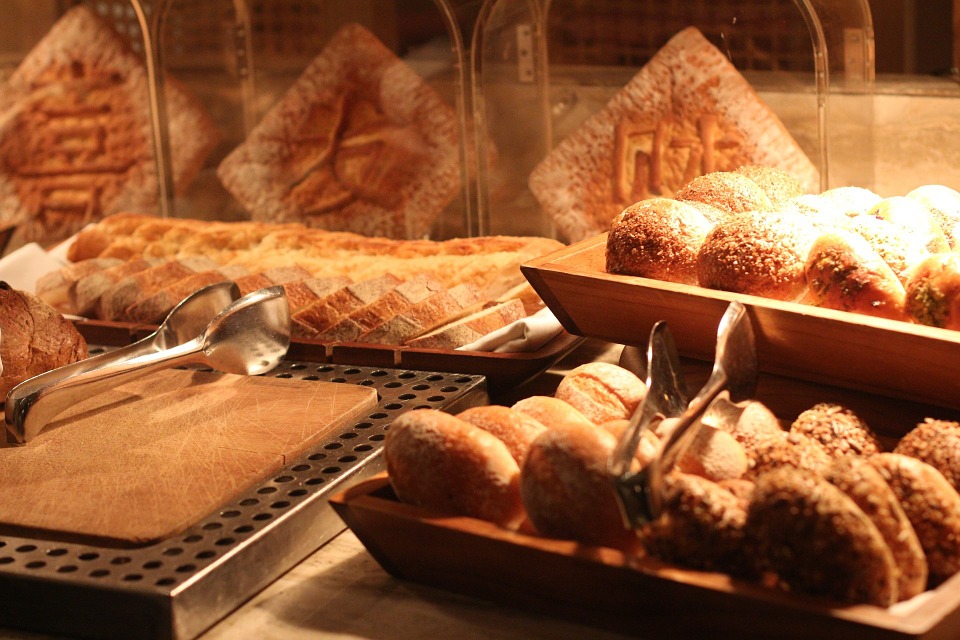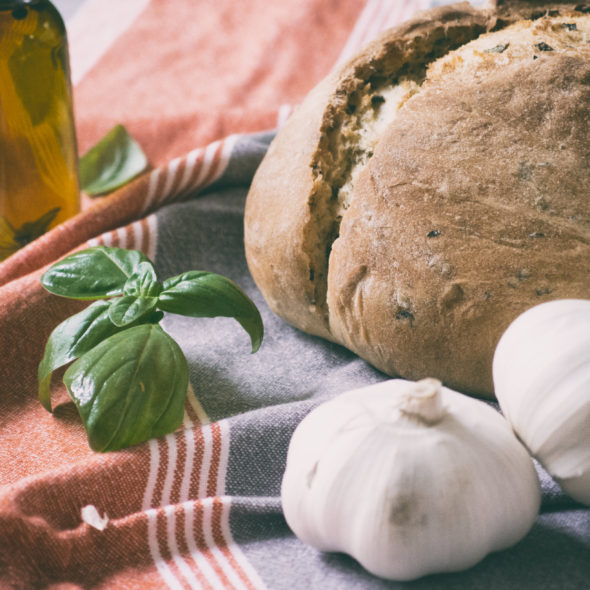Every dog owner knows the struggle: you're enjoying a delicious slice of toast, and your furry friend is staring at you with those big, pleading eyes. You know you shouldn't give in, but it's hard to resist their charm. "Can dogs even eat bread?" you wonder. It's a question I've pondered countless times, and I'm sure many of you have too.
Well, the answer is a little more nuanced than a simple yes or no. Just like with most things in dog ownership, moderation is key. A small piece of bread here and there probably won't hurt your pup, but there are definitely some types of bread that are better suited for canine consumption than others. There are also some serious dangers to be aware of.
This guide will be your comprehensive handbook to feeding bread to your dog. We'll cover safe and unsafe bread types, potential dangers, and even some fun recipes you can try together. We'll also address common questions and concerns.
Ready to unravel the mysteries of bread and dogs? Let's dive in!
(Part 1) The Basics: Can Dogs Eat Bread?

Let's start with the foundation. Is bread inherently bad for dogs? The answer is no, bread itself is not toxic to dogs. It's made from flour, water, and yeast, which are all generally safe. However, this doesn't mean all bread is created equal.
Is Bread Toxic to Dogs?
While bread itself isn't toxic, there are some ingredients commonly found in bread that can be harmful to dogs. We'll delve into those in a bit.
Is Bread Nutritious for Dogs?
The next question is, is bread nutritious for dogs? And the answer to that is a resounding no. Bread doesn't offer any significant nutritional value for dogs. Their primary source of nutrition should be a high-quality dog food. Think of bread as a treat, not a staple.
(Part 2) The Good, the Bad, and the Ugly of Bread for Dogs

Now that we've established the basics, let's dive into the specifics of bread and dogs. There are good bread choices, bad bread choices, and bread choices that are best avoided entirely.
The Good: Safe Bread Options for Dogs
When it comes to safe bread for dogs, the key is simplicity. Here are a few types of bread that are generally considered safe in small quantities:
- Plain white bread: This is a good starting point. As long as it's free from any added ingredients like garlic, onions, raisins, or chocolate, plain white bread is a relatively safe option. It's plain, simple, and unlikely to cause digestive issues. However, remember moderation is key.
- Whole wheat bread: While whole wheat bread is a healthier choice for humans, it can sometimes be a bit harder for dogs to digest. It's still a good choice if your dog enjoys it, but keep it to small portions.
- Plain rolls: Similar to plain white bread, rolls are generally okay, as long as they don't contain any added ingredients that could be harmful. I've personally found that my dog, a Jack Russell named Sparky, enjoys a small piece of a plain roll as an occasional treat.
- Sourdough bread: This might surprise you, but sourdough bread is actually easier for dogs to digest than white or wheat bread due to the fermentation process. The fermentation breaks down some of the complex sugars and starches, making it more digestible. But, as always, ensure it's plain sourdough without any added ingredients that could be harmful.
The Bad: Breads to Avoid Feeding Your Dog
Now, let's talk about the bread types that are best left off your dog's menu. These are the ones that can cause digestive issues, allergic reactions, and even more serious health problems.
- Bread with added sugar: Sugar is a big no-no for dogs. It can cause digestive issues, weight gain, and dental problems. So, avoid sugary breads like cinnamon rolls, sweet breads, or pastries.
- Bread with onions or garlic: Onions and garlic are toxic to dogs, even in small amounts. They can cause damage to red blood cells, leading to anemia. So, any bread containing these ingredients is off-limits.
- Bread with chocolate: Chocolate is another big no-no for dogs. It contains theobromine, a compound that can be toxic and even fatal to dogs. Even small amounts can cause vomiting, diarrhea, hyperactivity, and increased thirst. It's best to avoid any bread with chocolate.
- Bread with raisins or grapes: Raisins and grapes are also toxic to dogs, and can cause kidney failure. The exact reason why they're toxic is still unknown, but the effects can be serious. So, steer clear of any breads that contain these ingredients.
- Bread with nuts: Many nuts, like macadamia nuts, are toxic to dogs. They can cause vomiting, weakness, and even paralysis. Always check the ingredient list and avoid any breads with nuts.
- Bread with Xylitol: This artificial sweetener is extremely toxic to dogs and can even be fatal. It can cause a rapid drop in blood sugar, leading to liver failure. Many sugar-free products contain xylitol, so always check the ingredients list before offering your dog any bread or baked goods.
The Ugly: Dangers of Feeding Dogs Bread
While bread itself isn't toxic, it can be a cause for concern if not given in moderation. Here are some of the potential dangers:
- Digestive issues: Too much bread can lead to stomach upset, gas, diarrhea, and even constipation. This is especially true for dogs who aren't accustomed to eating bread. I learned this the hard way with my dog Sparky. One time, I gave him a whole slice of wheat bread. He ate it, but then proceeded to spend the entire afternoon with a bloated belly and a very unhappy expression. He certainly wasn't begging for more bread after that!
- Weight gain: Bread is high in carbohydrates, which can contribute to weight gain, especially if it's given in large amounts. Overweight dogs are at an increased risk for health problems, including joint issues, diabetes, and heart disease.
- Pancreatitis: In rare cases, excessive bread intake can trigger pancreatitis, a serious inflammation of the pancreas. Pancreatitis can be life-threatening and requires immediate veterinary care.
(Part 3) How Much Bread is Too Much for My Dog?

You're probably wondering, "how much bread is too much for my dog?" Well, it depends on your dog's size, breed, and activity level. There's no one-size-fits-all answer.
As a general rule of thumb, a small piece of plain bread once in a while shouldn't be a problem. However, avoid giving your dog large amounts of bread or making it a regular part of their diet.
Always consult with your veterinarian about the appropriate amount of treats, including bread, for your specific dog. They can provide personalized recommendations based on your dog's individual needs.
(Part 4) Fun and Safe Bread Recipes for Your Dog
Who says you can't share your love of baking with your furry friend? Here are a few fun and safe recipes you can try with your pup:
1. Peanut Butter Dog Biscuits
This classic recipe is a crowd-pleaser for dogs, and it's super easy to make! You'll need:
- 2 cups whole wheat flour
- 1 cup rolled oats
- 1/2 cup peanut butter (ensure it's xylitol-free)
- 1/4 cup water
Instructions:
- Preheat your oven to 350°F (175°C).
- Combine the flour, oats, peanut butter, and water in a large bowl. Mix until a dough forms.
- Roll out the dough on a lightly floured surface to about 1/4 inch thickness.
- Use cookie cutters to cut out shapes. You can also use a knife to cut squares or rectangles.
- Place the biscuits on a baking sheet and bake for 20-25 minutes, or until golden brown.
- Let the biscuits cool completely before giving them to your dog.
2. Sweet Potato and Apple Dog Treats
These treats are packed with healthy ingredients like sweet potato and apple, and your dog will love them! You'll need:
- 1 cup cooked sweet potato, mashed
- 1/2 cup cooked apple, diced
- 1 cup rolled oats
- 1/2 cup whole wheat flour
- 1 egg
- 2 tablespoons water
Instructions:
- Preheat your oven to 350°F (175°C).
- Combine all the ingredients in a large bowl and mix well.
- Roll out the dough on a lightly floured surface to about 1/4 inch thickness.
- Use cookie cutters to cut out shapes or use a knife to cut squares or rectangles.
- Place the treats on a baking sheet and bake for 15-20 minutes, or until golden brown.
- Let the treats cool completely before giving them to your dog.
3. Frozen Banana and Yogurt Dog Pops
These are a refreshing treat for hot days, and they're super easy to make. You'll need:
- 1 ripe banana, sliced
- 1/2 cup plain yogurt (ensure it's xylitol-free)
Instructions:
- Place a slice of banana in each ice pop mold.
- Pour yogurt over the banana slices.
- Freeze for at least 2 hours, or until solid.
- Let the pops thaw slightly before giving them to your dog.
(Part 5) Beyond Bread: A Word on Treats
The key takeaway here is that treats should be, well, treats. They should be given in moderation and never replace your dog's regular meals. Think of them as a small reward for good behavior or just a way to show your dog some love.
A good rule of thumb is to limit treats to 10% of your dog's daily calorie intake. You can work with your veterinarian to determine the appropriate amount of treats for your individual dog.
(Part 6) Dog-Friendly Bread Substitutes
If you're looking for a more nutritious and safe option for your dog, there are a few things you can try instead of bread:
- Dog biscuits: These are specially formulated for dogs and come in a variety of flavors and textures. They're a great option for training or simply as a reward.
- Carrots: Carrots are a great source of vitamins and fiber, and they're a healthy treat for dogs. They also help to keep their teeth clean.
- Apples: Apples are another good source of vitamins and fiber. Just make sure to remove the core and seeds before giving them to your dog.
- Sweet potatoes: Sweet potatoes are packed with nutrients and are a great source of energy for dogs. They're also a good source of Vitamin A. You can offer them cooked or baked.
(Part 7) Understanding Your Dog's Body Language
Every dog is different, and some might be more sensitive to certain foods than others. It's essential to pay attention to your dog's body language and be aware of any potential signs of intolerance or allergy.
Signs of Bread Intolerance or Allergy in Dogs
- Digestive upset: This can include diarrhea, constipation, gas, and vomiting. If you notice any of these symptoms after giving your dog bread, it's a good idea to hold off on giving them any more.
- Skin issues: Some dogs might experience itching, redness, or hair loss if they're allergic to something in bread. If you notice any skin changes, consult your veterinarian to determine the cause.
- Respiratory problems: In rare cases, a bread allergy might cause sneezing, coughing, or difficulty breathing. If you notice any respiratory issues, it's crucial to seek veterinary care immediately.
If you notice any of these symptoms after giving your dog bread, it's important to consult with your veterinarian. They can help you determine if your dog has an intolerance or allergy and recommend the best course of action.
(Part 8) FAQs
1. Can my dog eat bread crusts?
It's best to avoid bread crusts for dogs. They can be hard to chew and digest, and they can also pose a choking hazard. If you do give your dog bread crusts, make sure to break them into small pieces and supervise them closely. It's generally a good idea to err on the side of caution and avoid them entirely.
2. Is it okay to give my dog a little bit of bread as a treat?
Yes, a small piece of plain bread here and there is generally okay for dogs. Just make sure to avoid bread with any ingredients that are toxic to dogs. Remember, treat bread as an occasional treat, not a regular part of their diet.
3. Can I give my dog bread dough?
Absolutely not! Bread dough is dangerous for dogs, as it can rise in their stomach and cause serious health problems, including bloating, gas, and even death. The yeast in the dough ferments in the dog's stomach, releasing gas and causing the dough to expand. This can lead to a condition called bloat, which can be fatal if not treated promptly.
4. My dog seems to love bread. Is it okay to give him more than a small piece?
While your dog might love bread, it's important to remember that it's not a healthy food for them. It's best to stick to a small piece as an occasional treat. Instead, you can provide your dog with healthier treats, like dog biscuits, carrots, or apples.
5. My dog ate a whole loaf of bread. What should I do?
If your dog has eaten a large amount of bread, it's best to monitor them closely for any signs of digestive upset or other problems. You should also contact your veterinarian as soon as possible to get their advice. They might recommend inducing vomiting or monitoring the situation closely. Don't wait for signs of distress; it's always better to be safe than sorry.
(Part 9) A Final Word on Bread and Dogs
Remember, while bread itself isn't toxic to dogs, it's not a necessary part of their diet. Stick to the safe types of bread and give it in moderation. Treats should always be given in addition to a healthy and balanced diet, and your veterinarian is your best resource for determining the right amount of treats for your dog.
Always prioritize your dog's health and safety. If you have any doubts about what to feed your dog, it's always best to err on the side of caution and consult with your veterinarian.
Happy baking and bonding with your furry friend!
Everyone is watching
-

Can Dogs Eat Bananas? A Guide to Safe Treats
DOGS & PUPPIESThis comprehensive guide will delve into the world of canine nutrition, focusing on the popular question: can ...
-

Can Dogs Eat Oranges? (Is It Safe or Toxic?)
DOGS & PUPPIESThis article delves into the question of whether dogs can safely consume oranges. We'll explore the nutrition...
-

Can Dogs Eat Grapes? The Shocking Truth About This Fruit
DOGS & PUPPIESThis article delves into the controversial topic of grapes and dogs, exploring the potential dangers associate...
-

Why Do Dogs Eat Poop? Understanding Coprophagia in Dogs
DOGS & PUPPIESThis article delves into the perplexing phenomenon of coprophagia, the act of eating faeces, in dogs. We explo...
-

Can Dogs Eat Shrimp? A Guide to Safety and Risks
DOGS & PUPPIESThis comprehensive guide dives into the world of shrimp and dogs, exploring the potential benefits and risks a...
